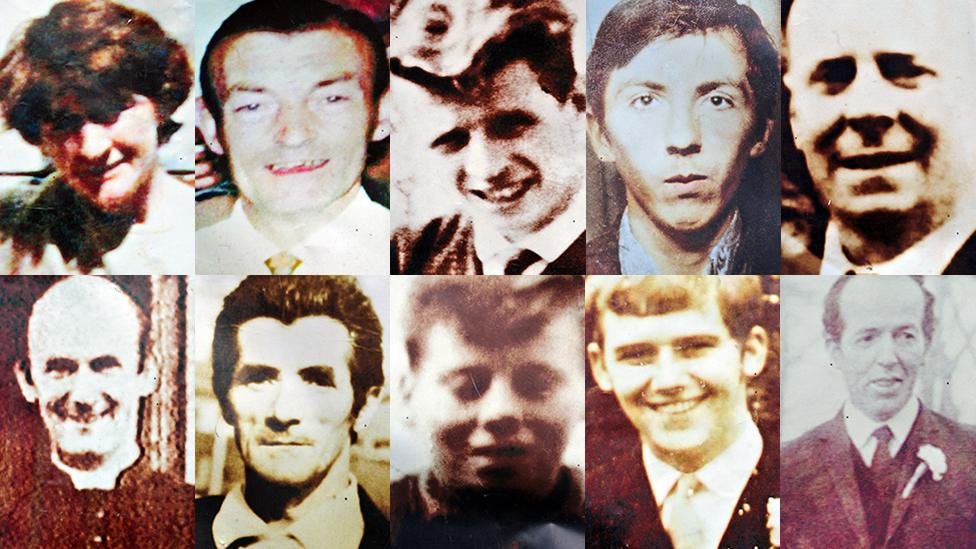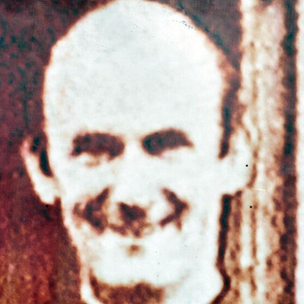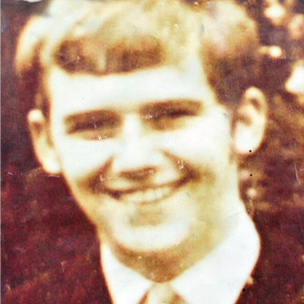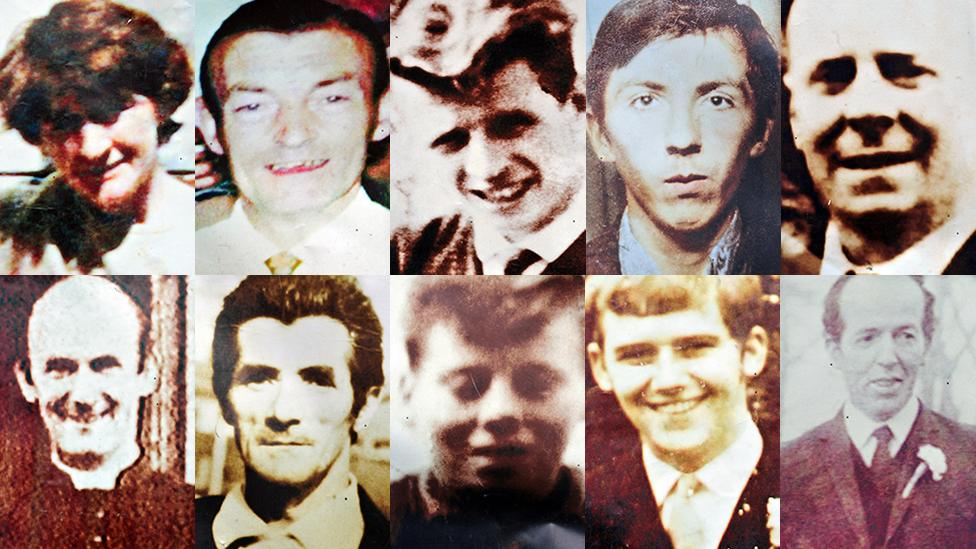Ballymurphy inquest: Claims UVF sniper fired at civilians
- Published

Relatives and supporters gathered outside Laganside Courts on Monday before proceedings got under way
A claim has been repeated that a UVF sniper may have contributed to the deaths of some of the 10 people killed in Ballymurphy in 1971.
The inquest into their deaths has heard of a so-called "Witness X", otherwise known as an "interlocutor".
They have provided further information to the coroner stating that a UVF sniper was active in the area at the time of some of the deaths.
The initial claim was made in May of this year.
The alleged sniper, who was said to be using a Mauser rifle, is now deceased.
The UVF information and statements provided by Witness X are now being checked and redacted.

Nine men and a woman were killed in Ballymurphy in August 1971
It is unclear how much weight the Coroners Service will give to the UVF claims.

Who were the victims?
Father Hugh Mullan, 38, and Francis Quinn, 19, were shot in an area of open ground behind Springfield Park
Daniel Teggart, 44, Joan Connolly, 44, Noel Phillips, 19 and Joseph Murphy, 41, were shot near the Henry Taggart Army base near Springfield Park
John Laverty, 20, and Joseph Corr, 43, were shot at separate points at the top of Whiterock Road
Edward Doherty, 31, was shot at the corner of Brittons Parade and Whiterock Road
John McKerr, 49, was shot outside the old Corpus Christi Parish
On Tuesday, statements given by the relatives of two of the victims - Fr Hugh Mullan and Frank Quinn - were read out at the inquest.
Fr Hugh Mullan

The 38-year-old priest, who was from Portaferry, County Down, and served a year in the Merchant Navy, had served in parishes in Belfast, County Antrim and County Down before coming to Ballymurphy.
His brother, Patsy, said Hugh loved sailing on Strangford Lough and when he served in the Good Shepherd Convent in Belfast he would play guitar and sing to the children.
He said that on the night of 9 August 1971, he heard that a priest had been shot in Ballymurphy.
"I knew it would be him," he said.
"When I was later told that he was dead, I phoned our doctor and asked him to come to be with my mother as I didn't know how she would cope with this news. She was in a terrible state and had to be sedated."
Fr Mullan's cousin, Gabriel Ellison, said that as a child he had been sailing a toy boat off the slip in Portaferry when he fell into the water.
"Hughie ran out of his house and jumped in after me and pulled me out," he said.
"I was surely gone only for his super actions, he was at QUB [Queen's University Belfast] then and had learned life saving skills."
Frank Quinn

Frank Quinn was 19 and from west Belfast. While he had worked in a number of jobs after leaving school, his main one was a window cleaner.
He married his wife, Ann, when he was 17 and they had a daughter, Angela, soon afterwards.
Ann was pregnant with their second daughter Frances, when Mr Quinn was shot dead.
Frank's younger brother Pat recalled the moment his father came home from work and told the family that Frank had been shot.
"I said 'was he wounded? Was he wounded?' and he said "no, he's dead'. Those three words changed me and my family's lives forever."
Angela Sloan, Frank Quinn's elder daughter, said growing up without her father was heart-breaking and that her mother never remarried "such was her love for my daddy".
"He should have been there for us but all we had of him was pictures," she said.
"Daddy now has four amazing grandchildren and a little great grandson, Ronan. We were all robbed of his presence in our lives."

Identifying witnesses
Meanwhile, witness statements have been requested from 127 potential military witnesses.
Concern was expressed by barristers for some of the families that some ex-soldiers would not be cooperating with the inquest.
"There is widespread and deep concern at what appears to be a boycott at what is a critical point in this inquest," said John Mansfield QC.
He urged the coroner to subpoena those former soldiers called to give evidence who were unwilling to do so.
Work to identify witnesses who may be called to give oral evidence is continuing.
There have been 32 new statements provided by civilian witnesses.
Military witnesses will not be called to give evidence until after Christmas.
Known by many as the Ballymurphy Massacre, the shootings of nine men and one woman took place over three days in August 1971.
At the time, the Army said those killed were either IRA gunmen or caught in the crossfire between soldiers and gunmen.
The families of victims said they believe the evidence produced during the inquests will show that their relatives were innocent and were targeted deliberately.
- Published12 November 2018

- Published2 May 2018

- Published6 September 2018
